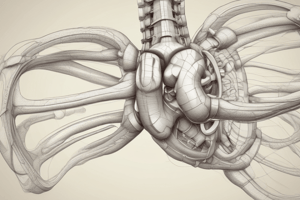Podcast
Questions and Answers
Which term describes the rotation of the pelvis, and often the superimposed trunk, over relatively fixed femurs?
Which term describes the rotation of the pelvis, and often the superimposed trunk, over relatively fixed femurs?
- Hip arthrokinematics
- Iliofemoral kinematics
- Pelvic-on-femoral hip osteokinematics (correct)
- Femoral-on-pelvic hip osteokinematics
Which ligament limits hip abduction and extension, and to a lesser degree, external rotation?
Which ligament limits hip abduction and extension, and to a lesser degree, external rotation?
- Ischiofemoral ligament
- Pubofemoral ligament (correct)
- Iliofemoral ligament
- Ligamentum teres
Which motion is described by femoral-on-pelvic hip osteokinematics?
Which motion is described by femoral-on-pelvic hip osteokinematics?
- Internal and external rotation
- Flexion and extension (correct)
- Anterior and posterior pelvic tilt
- Abduction and adduction
Which type of joint is the hip joint?
Which type of joint is the hip joint?
Which ligament limits hip hyperextension?
Which ligament limits hip hyperextension?
During ipsidirectional lumbopelvic rhythm, what is the relationship between the pelvis and lumbar spine?
During ipsidirectional lumbopelvic rhythm, what is the relationship between the pelvis and lumbar spine?
What is the purpose of ipsidirectional lumbopelvic rhythm?
What is the purpose of ipsidirectional lumbopelvic rhythm?
When is contradirectional lumbopelvic rhythm used?
When is contradirectional lumbopelvic rhythm used?
What is the sequence of lumbo-pelvic rhythm during trunk extension?
What is the sequence of lumbo-pelvic rhythm during trunk extension?
What is the force-couple typically shown between during hip flexion?
What is the force-couple typically shown between during hip flexion?
Flashcards are hidden until you start studying
Study Notes
Hip Joint and Movement
- The term "lumbopelvic rhythm" describes the rotation of the pelvis, and often the superimposed trunk, over relatively fixed femurs.
- The iliofemoral ligament limits hip abduction and extension, and to a lesser degree, external rotation.
- Femoral-on-pelvic hip osteokinematics is described by the motion of the femur moving on the pelvis.
- The hip joint is a type of ball-and-socket joint.
Lumbopelvic Rhythm
- During ipsidirectional lumbopelvic rhythm, the pelvis and lumbar spine move together in the same direction.
- The purpose of ipsidirectional lumbopelvic rhythm is to facilitate movement and reduce stress on the lumbar spine.
- Contradirectional lumbopelvic rhythm is used when the pelvis and lumbar spine move in opposite directions, such as during heavy lifting or bending.
- The sequence of lumbo-pelvic rhythm during trunk extension is lumbar spine extension, followed by pelvic rotation.
Hip Flexion
- The force-couple typically shown during hip flexion is between the iliopsoas and the tensor fasciae latae.
Studying That Suits You
Use AI to generate personalized quizzes and flashcards to suit your learning preferences.




